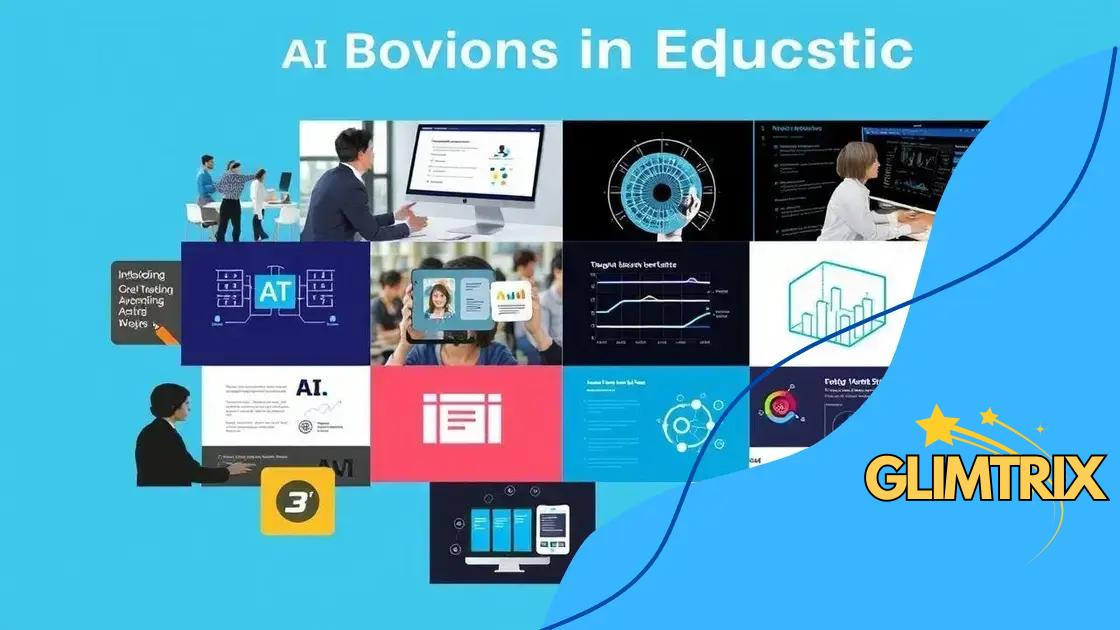AI-driven special education tools transforming learning

AI-driven special education tools enhance learning by providing personalized support, utilizing advanced technologies like intelligent tutoring systems and virtual reality to meet individual student needs effectively.
AI-driven special education tools are revolutionizing the way we approach learning for students with unique needs. Have you ever considered how these tools can tailor educational experiences? Let’s dive into this fascinating topic!
Understanding AI-driven tools for education
Understanding AI-driven tools for education is essential to reimagining how we teach and learn. These innovative technologies offer tailored solutions that cater to individual student needs. By leveraging advanced algorithms, educators can create environments where every learner can thrive.
What Are AI-driven Tools?
AI-driven educational tools utilize artificial intelligence to improve the learning experience. They analyze student data and provide personalized recommendations. This ensures that resources are aligned with each student’s unique learning pace and style.
- Adaptive learning platforms
- Intelligent tutoring systems
- Learning analytics tools
- Speech recognition software
These tools can adjust the curriculum to support students who may struggle in traditional educational settings. For example, if a student is having difficulty with a specific concept, the AI can recommend additional practice or varied resources.
Benefits of Using AI in Education
One major benefit of using AI-driven tools is the ability to reduce the workload for teachers. With automation of administrative tasks, educators can focus more on direct student interaction, fostering a better learning environment. Additionally, AI tools provide real-time feedback, allowing educators to modify their approach swiftly.
The integration of these tools also promotes engagement among students. When lessons are tailored to their interests and strengths, students become more motivated to learn. Moreover, these technologies can identify students at risk of falling behind, enabling timely interventions.
Benefits of AI in special education
The benefits of AI in special education are numerous and impactful. These tools can help create personalized learning experiences that cater to individual strengths and challenges. By analyzing student data, AI systems can identify specific needs and suggest appropriate resources.
Enhanced Learning Opportunities
One significant advantage of AI tools is their ability to provide enhanced learning opportunities. With AI-driven solutions, educators can tailor lessons that match the learning pace of each student. This ensures that everyone receives the support they need.
- Personalized lesson plans
- Adaptive assessments
- Accessible learning materials
- Real-time progress tracking
Moreover, these tools often include interactive elements, which can boost student engagement. Children with different learning abilities find it easier to grasp concepts when they interact with dynamic materials designed for their unique needs.
Support for Educators
AI in special education not only benefits students but also provides invaluable support to educators. By automating administrative tasks, teachers have more time to focus on instruction. This can lead to better educational outcomes as they can spend more time on meaningful interactions with their students.
Additionally, AI can analyze teaching effectiveness and suggest strategies for improvement. Educators can access insights about which methods work best for their classrooms, enabling them to refine their approaches continuously.
Examples of successful AI applications

There are many successful AI applications in education that demonstrate the power of technology in creating effective learning environments. These real-world examples show how AI can enhance teaching methods and support diverse learning needs.
Intelligent Tutoring Systems
One notable example is intelligent tutoring systems. These platforms provide personalized instruction to students, adapting their teaching styles based on individual progress. Students benefit from targeted feedback and resources, which helps them grasp challenging concepts more easily.
- Knewton: This system offers adaptive learning technology to tailor educational experiences.
- DreamBox Learning: An online math program that adjusts to students’ learning levels.
- Smart Sparrow: Allows educators to create adaptive lessons based on student needs.
These systems help ensure that each student receives the unique support they require, so they can learn at their own pace and build confidence.
Speech Recognition Tools
Another exciting application is speech recognition technology, which benefits students, especially those with learning disabilities. Tools like Dragon NaturallySpeaking enable voice-to-text capabilities, making it easier for students to participate in classrooms and complete assignments.
By allowing students to express their thoughts more freely, these tools foster creativity and innovation. Moreover, using speech recognition can help in developing essential communication skills.
Data Analytics Platforms
Data analytics platforms play a crucial role in AI applications within special education. Programs such as Classcraft and Edmodo help educators gather insights on student performance.
By analyzing patterns in data, these platforms can identify when students need additional support or modifications to their learning plans. This proactive approach ensures that interventions can be implemented before students fall behind.
Challenges in implementing AI-driven education
Implementing AI-driven education comes with several challenges that educators and institutions must navigate. Understanding these hurdles is essential for successful integration and for maximizing the benefits of technology in learning environments.
Data Privacy Concerns
One major challenge is the issue of data privacy. AI systems rely on large amounts of student data to provide personalized experiences. Schools must ensure that they are handling this data responsibly and in compliance with regulations like FERPA.
- Understanding data protection laws
- Establishing secure data handling practices
- Obtaining parental consent
- Training staff on data privacy issues
Without proper measures in place, there is a risk of exposing sensitive information, which can lead to significant consequences for students and institutions alike.
Integration with Existing Systems
An additional challenge involves integrating AI tools with existing educational systems. Many schools may use legacy systems that could complicate the adoption of new technologies. Ensuring that these systems can communicate effectively is vital.
Some institutions find it difficult to allocate resources for technology upgrades or staff training, which can slow down the implementation process. Successfully addressing these logistical issues is crucial for a smooth transition.
Training and Support
Furthermore, adequate training and support for educators are essential for successful implementation. Teachers must be comfortable using AI tools and understanding their functionalities to leverage them effectively in the classroom.
This requires ongoing professional development and technical support. If educators do not feel confident using AI technologies, they may not use them to their full potential, diminishing the benefits for students.
Future trends in special education technology
Future trends in special education technology are exciting and hold great promise for improving learning experiences. As technology continues to evolve, educators and students alike will benefit from new tools and methods tailored to unique learning needs.
Increased Personalization
One significant trend is the move towards increased personalization in education. Using AI, educational tools will more accurately assess individual student abilities and tailor lessons accordingly. This means that each student can have a learning plan specifically designed for their needs.
- Adaptive learning platforms that respond to student progress
- Personalized feedback mechanisms for continuous improvement
- Learning paths adjusted based on student engagement
- Access to a variety of learning resources tailored to different styles
As these tools advance, they will enable teachers to provide even more effective support for their students.
Virtual and Augmented Reality
Another exciting development is the incorporation of virtual and augmented reality (VR/AR). These technologies allow students to experience immersive learning environments that can make complex subjects easier to understand. Imagine a student exploring the solar system or exploring historical events in a 3D space.
This hands-on approach helps students grasp concepts better by engaging multiple senses, making learning both fun and effective. Furthermore, VR/AR can provide safe spaces for students to practice social skills and real-life scenarios.
Enhanced Collaboration Tools
Collaboration tools will also play a crucial role in shaping the future of special education technology. Increased use of online platforms allows students to connect with peers and educators beyond their classrooms, broadening their support networks.
These tools can include features such as virtual group projects, online discussion boards, and shared resources that promote teamwork. By working together, students enhance their communication and interpersonal skills, crucial for their development.
FAQ – Frequently Asked Questions about AI-driven Special Education Tools
How do AI-driven tools personalize education for students?
AI-driven tools assess student data to create customized learning experiences tailored to each individual’s needs and abilities.
What are some examples of successful AI applications in education?
Examples include intelligent tutoring systems, speech recognition tools, and data analytics platforms that enhance learning and provide valuable insights.
What challenges might schools face when implementing AI technology?
Schools may encounter data privacy concerns, integration issues with existing systems, and a need for proper training and support for educators.
What future trends can we expect in special education technology?
Future trends include increased personalization, the use of virtual and augmented reality, and enhanced collaboration tools to engage students more effectively.





